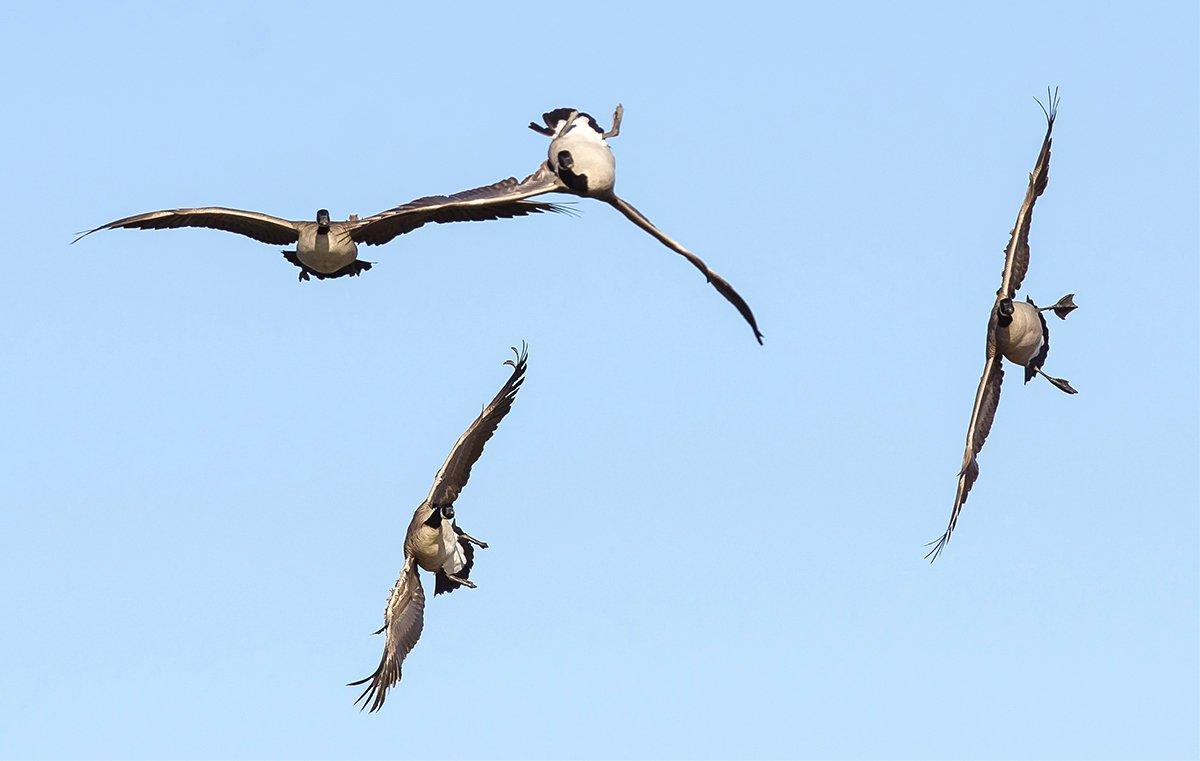Zigzagging Aerial Acrobatics Create Memorable Scenes
We love watching the landing approach of any duck or goose, our heartbeats accelerating and focus narrowing as a distant bird suddenly morphs from a casual passerby to a cupped-and-committed volunteer.
But when you add whiffling to the mix, the excitement level ratchets up another notch or two.
When a duck or goose rapidly twists and rolls its body almost 180 degrees while keeping its wings locked, descending quickly as it does so, you know things are about to get real. The behavior has many nicknames — including flipping and barrel rolling — but the official description is whiffling.
The Wikipedia entry on the subject provides a pretty good definition: Whiffling is a term used in ornithology to describe the behavior whereby a bird rapidly descends with a zigzagging, side-slipping motion. Sometimes to whiffle, a bird flies briefly with its body turned upside down but with its neck and head twisted 180 degrees around in a normal position. The aerodynamics (that) usually give a bird lift during flying are thereby inverted, and the bird briefly plummets toward the ground before this is quickly reversed and the bird adopts a normal flying orientation. This erratic motion resembles a falling leaf and is used to avoid avian predators, or may be used by geese … to avoid a long, slow descent over an area where wildfowling is practiced.
I'd add that high-flying ducks and geese also whiffle when they recognize a destination, such as a hot feeding area, secure refuge or unpressured midday loafing spot. Puddle ducks seem to whiffle more than divers, which makes sense because their flight paths are often much higher than those of diving ducks, and dabblers sometimes need to lose serious air as they descend. I've also seen sandhill cranes do it — though not often — which is pretty impressive considering the great size and wingspan of the birds.
Mostly, I associate whiffling with geese — specifically the big Canadas and mid-sized Mississippi Valley Population migrants I hunt in Wisconsin. My buddies and I used to marvel from our field blinds as honkers would lift high off lakes or backwaters and then flip, as we called it, downward toward our spreads in an oat or wheat field. Often, it signified that we were on the X and about to enjoy a banner shoot.
But not always. If our concealment was lacking or sharp-eyed birds noticed something else out of place, whiffling geese would suddenly rocket skyward or skirt to the left or right of our decoys, just out of range. Sure, they wanted in badly enough to flip their bodies in midair, but when their evolution-sharpened survival instincts kicked in, they took no chances.
The predator avoidance aspect of whiffling is also fascinating. I've seen a few ducks whiffle wildly when avoiding eagles over big water, and their efforts are almost always successful. The most memorable display I witnessed occurred in South Dakota, when a green-winged teal almost whiffled his way out of the clutches of a prairie falcon. Ultimately, the raptor won, grabbing the little duck and flying off for a bit but then dropping the teal, which plummeted to the water with a geyser-like splash.
Whenever we see ducks or geese whiffle, the behavior provides a reminder of how incredibly well adapted these flying machines are to their environs. Look for it the next time to set up for honkers in a field or wait to ambush greenheads at a hot slough. Appreciate the world-class agility you're witnessing. But then get ready to shoot. Chances are, those birds will be feet-down over your blocks in seconds.
Click here for more Realtree waterfowl hunting content. And check us out on Facebook.







